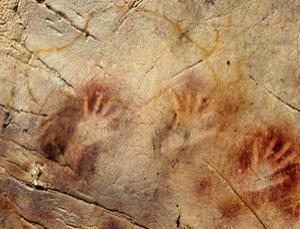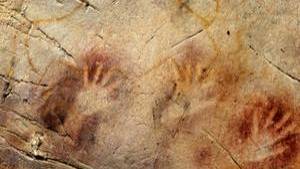Oldest confirmed cave art is a single red dot
Source: newscientist.com
As cave art goes, it doesn’t look like much: a single red dot, hidden among a scatter of handprints and drawings of animals on the wall of El Castillo cave in northern Spain.But this red dot is at least 40,800 years old, making it the oldest known piece of cave art in Europe. At that time modern humans had only just migrated out of Africa, raising a tantalising possibility: that the dot was drawn by a Neanderthal. If that’s the case, our extinct cousins may have had the rudiments of written language.

A hand stencil in El Castillo cave, Spain, has been dated to earlier than 37,300 years ago and a red dot to earlier than 40,600 years ago, making them the oldest cave paintings in Europe (Image: Pedro Saura)
While cave art is common throughout western Europe, the oldest dated examples are those in Chauvet cave in France, which have controversially been dated to between 35,000 and 30,000 years ago.
But many other pieces of cave art have never been dated. Standard radiocarbon dating only works when paintings were made using organic material like charcoal. Anything drawn with minerals like ochre, or just carved into the wall, can not be carbon dated.
Now, Alistair Pike of the University of Bristol, UK, and colleagues have come up with a partial solution that will put a minimum age on some previously un-datable paintings.
As water seeps through rock and dribbles over the cave surface, it leaves behind a thin layer of calcite. This contains radioactive uranium, which slowly decays into thorium at a known rate.
So, by measuring how much uranium has decayed into thorium, Pike figured he could determine the age of the calcite layer.
If the calcite overlays a painting, it will provide a minimum age for that art.
[...]
Although dramatic drawings of large animals tend to be the focus of attention, most cave art consists of simple symbols like the ones Pike studied. Nowell and her colleague Genevieve von Petzinger have found the same symbols drawn all over the world, so they may represent an early form of written language. Could this mean Neanderthals were able to write? Only the discovery of similar, but older symbols will say for sure.
Read the full article at: newscientist.com






















